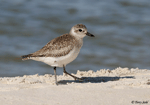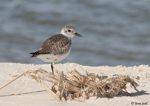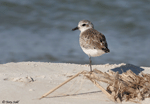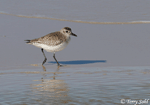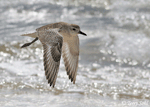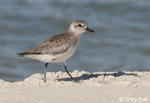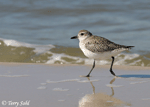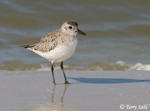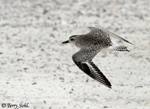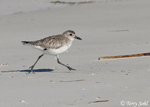Black-bellied Plover
Pluvialis squatarola
| Length: 12 inches | Wingspan: 24 inches | Seasonality: Migrant |
| ID Keys: Short thick black bill, black wingpit and white rump and tail in flight. Breeding birds rich black and white, non-breeding in earth tones and much duller | ||
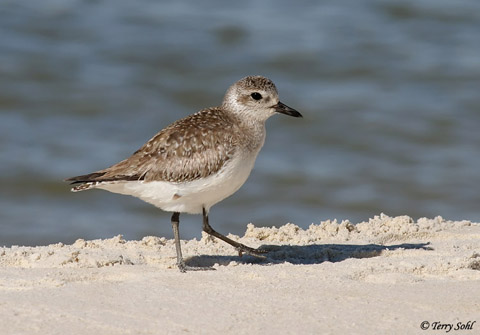 The
Black-bellied Plover can be found on six different continents during the
winter season, but breeds only on Arctic tundra. Most migrate
southward along the coastlines, but small numbers move through the interior
of the continent, where they may stop to forage in bare agricultural fields.
They are the largest of the North American plovers. Note the bird to
the right is in non-breeding plumage. Birds in breeding plumage are
much more richly colored and patterned, with a black-belly offset by white
rump, cap, and neck, and a boldly patterned back and wings.
The
Black-bellied Plover can be found on six different continents during the
winter season, but breeds only on Arctic tundra. Most migrate
southward along the coastlines, but small numbers move through the interior
of the continent, where they may stop to forage in bare agricultural fields.
They are the largest of the North American plovers. Note the bird to
the right is in non-breeding plumage. Birds in breeding plumage are
much more richly colored and patterned, with a black-belly offset by white
rump, cap, and neck, and a boldly patterned back and wings.
Habitat: Found in Arctic tundra during summer breeding season. In migration and winter, they are primarily found on sandy beaches and tidal flats, although those few that do migrate through the interior of the continent will also stop on overgrazed pastures, short-grass prairies, and freshly plowed fields.
Diet: Primarily feeds on insects on its summer breeding grounds. In migration and in winter, also eats mollusks, crustaceans, marine worms, and some plant material.
Behavior: Can be heard whistling either day or night. Finds most food by sight, running along the ground and pausing periodically to peck at edible bits.
Interactive eBird Map: Click to access an interactive eBird map of Black-bellied Plover sightings
Song: Mournful three-note whistle, with 2nd note lower in pitch.
Migration: Summers throughout the Arctic. Winters in an incredible number of regions, from the coasts of the United States, southward all the way through South America, and even in Africa and Australia. Note that small numbers of these, mostly immatures, can be seen along U.S. coastlines at any time during the year.
Similar Species: American Golden Plover, Pacific Golden-Plover
Status: Generally stable throughout its normal range.
Further Information:
- USGS Patuxent Bird Identification InfoCenter, Black-bellied Plover
- WhatBird - Black-bellied Plover
- Audubon Guide - Black-bellied Plover
Photo Information: Bon Secour National Wildlife Refuge, Alabama - February 13th, 2008 - Terry Sohl
Additional Photos: Click on the image chips or text links below for additional, higher-resolution Black-bellied Plover photos.
| Click on the map below for a higher-resolution view |
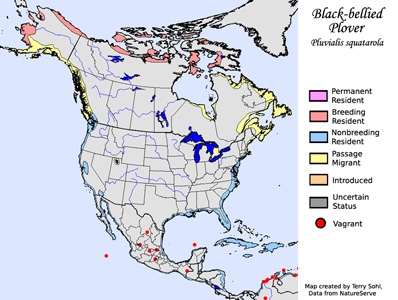 |
| South Dakota Status: Uncommon migrant throughout the state. |
Additional Black-bellied Plover Photos
Click for a higher-resolution version of these photos
